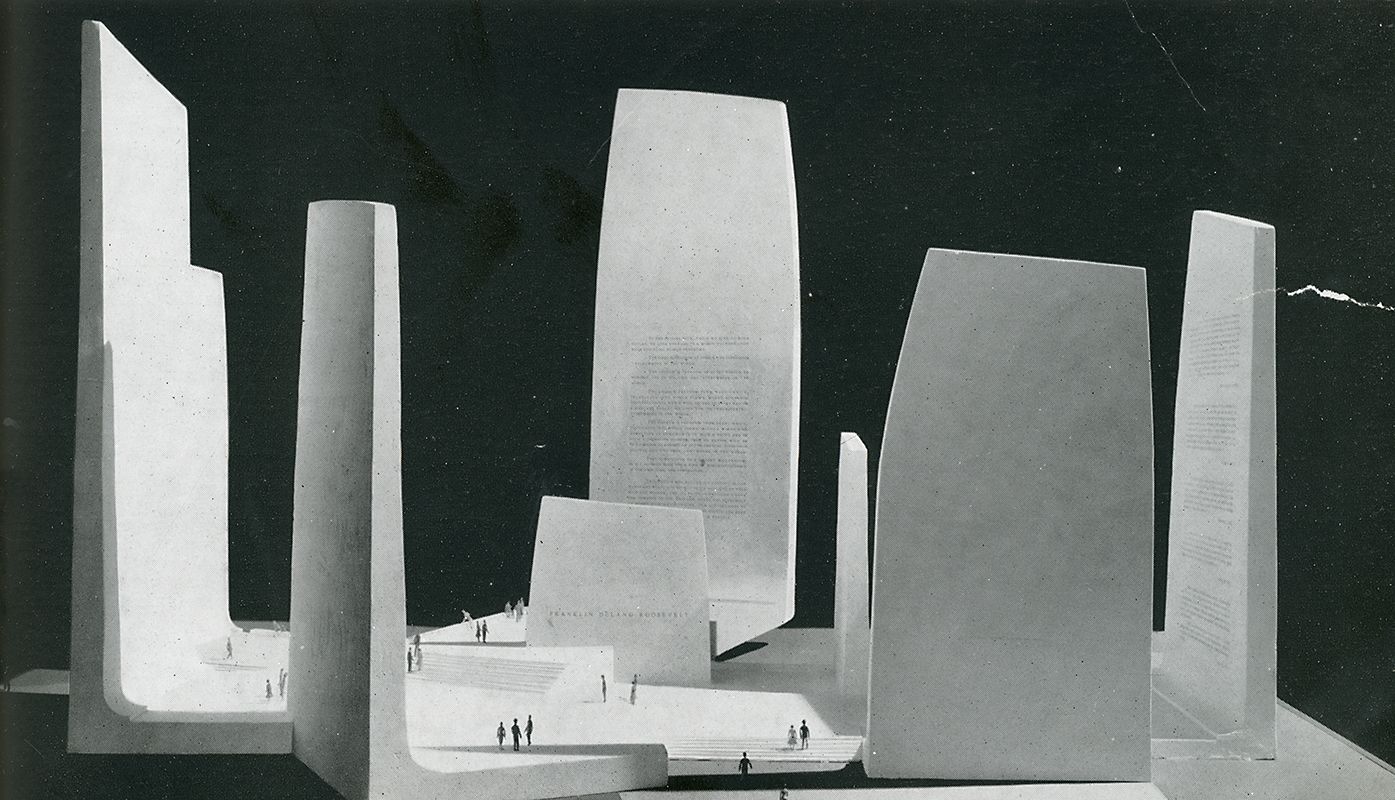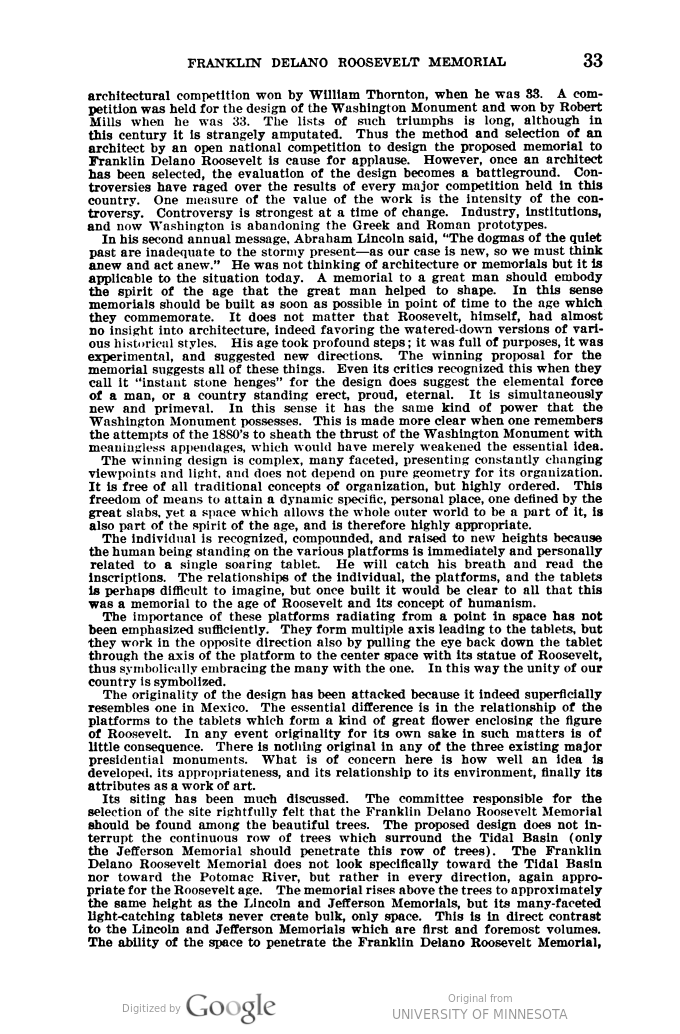Notes Concerning the Franklin Delano Roosevelt Memorial Competition - June 8, 1962
INTRODUCTION
On August 11, 1955 the United States congress passed a joint resolution establishing the Franklin Delano Roosevelt Memorial Commission which held design competition for the memorial in 1959. Close to 600 architects and architectural firms submitted proposals, and Congress required the winning design be approved the Commission of Fine Arts. The competition jury - which included Paul Rudolph as a member - awarded first prize in December 1960 to the New York City architectural firm of Pedersen and Tilney (William Pedersen and Bradford Tilney, their associates Joseph Wasserman and David Beer, and Norman Hoberman, sculptor).
The winning proposal by Pedersen and Tilney.
According to Isabelle Hyman in the article “Marcel Breuer and the Franklin Delano Roosevelt Memorial”:
But the abstract format of the winning design - eight huge concrete stelae, one of them 167 feet high, raised on platforms and set at angles to each other, inscribed with quotations from Roosevelt’s speeches - generated controversy. It was ridiculed in the popular press as “bookends” and “instant Stonehenge,” and it was not approved by the Commission of Fine Arts.
On October 18, 1962 Congress passed another joint resolution to direct the Franklin Delano Roosevelt Memorial Commission to consider changes to the design in order to obtain approval from the Fine Arts Commission. Pedersen and Tilney submitted a revised design to the Fine Arts Commission in May 1964. In June 1964, the Commission voted to approve the revision over the objections of the Roosevelt family, who did not like either version. In the end, Congress did not approve to proceed with the design.
The below was written by Paul Rudolph and read at a congressional hearing on June 8, 1962 in support of the first proposal by Pedersen and Tilney.
The text was reproduced in Franklin Delano Roosevelt memorial : hearings before the Subcommittee on Enrolled Bills and Library of the Committee on House Administration, Eighty-seventh Congress, second session, on H.R. Res. 712 and H.J. Res. 713, to authorize and direct the Franklin Delano Roosevelt memorial commission to raise funds for the construction of a memorial.
[Note: in transcribing this text, we have retained most of the grammar, spelling, capitalization, and construction.]
======================================
STATEMENT OF PAUL M. RUDOLPH, CHAIRMAN, SCHOOL OF ARCHITECTURE, YALE UNIVERSITY, AND MEMBER OF THE JURY TO SELECT MEMORIAL DESIGN
Mr. Jones: We will now hear from Mr. Paul M. Rudolph. Do you have a prepared statement, Mr. Rudolph, you would like to read?
Mr. Rudolph: I would like to read a portion of it.
Mr. Jones: Very well, and the entire statement will be made a part of the record.
Mr. Rudolph: Can a democracy use its artists? The United States, in its early days gave a resounding "Yes" and the Republic has benefited ever since. The most important single building of the country, our National Capitol, is the result of a national architectural competition won by William Thornton, when he was 33. A competition was held for the design of the Washington Monument and won by Robert Mills when he was 33. The list of such triumphs is long, although in this century it is strangely amputated. Thus the method and selection of an architect by an open national competition to design the proposed memorial to Franklin Delano Roosevelt is cause for applause.
However, once an architect has been selected, the evaluation of the design becomes a battleground. Controversies have raged over the results of every major competition held in this country. One measure of the value of the work Is the intensity of the controversy. Controversy is strongest at a time of change. Industry, institutions, and now Washington is abandoning the Greek and Roman prototypes.
In his second annual message, Abraham Lincoln said,
The dogmas of the quiet past are inadequate to the stormy present - as our case is new, so we must think anew and act anew.
He was not thinking of architecture or memorials but it is applicable to the situation today. A memorial to a great man should embody the spirit of the age that the great man helped to shape. In this sense memorials should be built as soon as possible in point of time to the age which they commemorate. It seems to me It does not matter that Roosevelt, himself, had almost no insight into architecture, indeed favoring the watered-down versions of various historical styles. His age took profound steps; it was full of purpose, it was experimental, and suggested new directions. The winning proposal for the memorial suggests all of these things. Even its critics recognized this when they call it "instant Stonehenge" for the design does suggest the elemental force of a man, or a country standing erect, proud, eternal. It is simultaneously new and primeval. In this sense it has the same kind of power that the Washington Monument possesses. This is made more clear when one remembers the attempts of the 1880’s to sheath the thrust of the Washington Monument with meaningless appendages which would have merely weakened the essential idea.
The winning design is complex, many faceted, presenting constantly changing viewpoints and light, and does not depend on pure geometry for its organization. It is free of all traditional concepts of organization, but highly ordered. This freedom of means to attain a dynamic specific, personal place, one defined by the great slabs, yet a space which allows the whole outer world to be a part of it, is also part of the spirit of the age, and is therefore highly appropriate.
The individual is recognized, compounded, and raised to new heights because the human being standing on the various platforms is immediately and personally related to a single soaring tablet. He will catch his breath and read the inscriptions. The relationships of the individual, the platforms, and the tablets are perhaps difficult to imagine, but once built it would be clear to all that this was a memorial to the age of Roosevelt and its concept of humanism.
The importance of these platforms radiating from a point in space has not been emphasized sufficiently. They form multiple axes leading to the tablets, but they work in the opposite direction also by pulling the eye back down the tablet through the axis of the platform to the center space with its statue of Roosevelt, thus symbolically embracing the many with the one. In this way the unity of our country is symbolized.
The originality of the design has been attacked because it indeed superficially resembles one in Mexico. The essential difference is in the relationship of the platforms to the tablets which form a kind of great flower enclosing the figure of Roosevelt. In any event originality for its own sake in such matters is of little consequence. There is nothing original in any of the three existing major Presidential monuments. What is of concern here is how well an idea is developed, its appropriateness, and its relationship to its environment, finally its attributes as a work of art.
Its siting has been much discussed. The committee responsible for the selection of the site rightfully felt that the Franklin Delano Roosevelt Memorial should be found among beautiful trees. The proposed design does not interrupt the continuous row of trees which surround the Tidal Basin (only the Jefferson Memorial should penetrate this row of trees). The Franklin Delano Roosevelt Memorial does not look specifically toward the Tidal Basin nor toward the Potomac River, but rather in every direction, again appropriate for the Roosevelt age. The memorial rises above the trees to approximately the same heights as the Lincoln and Jefferson Memorials. I believe I am right in saying they are approximately 155 feet whereas the tallest tablet is 168 feet, but that should be compared to the Washington Monument, which is 550 feet, so there is no question the Washington Monument would dominate in terms of height. The average height of the tablets is below the height of either the Jefferson or Lincoln Memorials
The many-faceted light-catching tablets of the memorial never create bulk, only space. This is in direct contrast to the Lincoln and Jefferson Memorials which are first and foremost volumes. One is a rectangle and the other is a circle. The ability of the space to penetrate the Franklin Delano Roosevelt Memorial, plus the screen of trees surrounding it, allows it to act as a counterpoint to the Lincoln and Jefferson Memorials rather than as a competing element. It seems to me this is very important in terms of the relationship of the three major existing Presidential memorials.
The notion that the Franklin Delano Roosevelt Memorial does not conform to the spirit or the letter of L'Enfant's plan, is without meaning since L'Enfant's plan was based on an open 4-mile stretch of water stretching south of the White House. This has long since been partially filled in with land, trees, bridges, highways, and some buildings, so that the original concept is invalidated. I believe that the proposed Franklin Delano Roosevelt Memorial truly reflects the spirit of the times which it memorializes and will consequently be a true and lasting monument. If built, it will say to the world that the United States of America has artists that are capable of representing the highest aspirations of its people.
Mr. Jones: Thank you, Mr. Rudolph. Any questions?
Mr. Thompson: I have a very brief question. Although there has been no final determination as to what materials might be used, the concrete proposal seems to be in the lead. Do you have any doubt as to its durability?
Mr. Rudolph: I have no doubt whatsoever. Concrete comes in many different forms. It is like the goods of which your suits is made; it can be good or not very good.
Mr. Thompson: Mine is not.
Mr. Rudolph: If we can send a man to the moon certainly we can use a 20th-century material like concrete and make it last through the ages.
Mr. Thompson: Do you feel that with structural steel of some kind inside there is any danger of rust bleeding through in this type of material?
Mr. Rudolph: Not at all. If the reinforcing bars are held back 8 inches from the concrete there is no reason for It to rust.
Mr. Thompson: The reason I asked that question, we have some letters in opposition to the effect that the concrete would not be durable, that it would rust, and that over the years it would virtually disintegrate.
Mr. Rudolph: That is easy to understand because concrete is a relatively new material. It has gone through its birth pangs. But at this point in its development there is no question about its durability.
Mr. Jones: Any other questions? Thank you, Mr. Rudolph.
Mr. Rudolph: Thank you.
======================================






